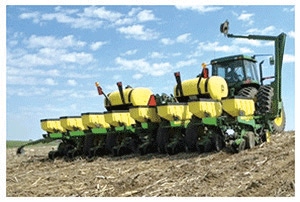
With corn planting for the 2011 season just around the corner, what growers do at this critical time can have a major impact on the crop’s performance, says Erick Larson. “While early planting is often a significant factor in success with corn, growers who rush the process and don’t follow sound practices can end up costing themselves yield,” he said at the annual Delta Ag Expo at Cleveland, Miss.

With corn planting for the 2011 season just around the corner, what growers do at this critical time can have a major impact on the crop’s performance, says Erick Larson.
“While early planting is often a significant factor in success with corn, growers who rush the process and don’t follow sound practices can end up costing themselves yield,” he said at the annual Delta Ag Expo at Cleveland, Miss.
“A uniform stand is paramount to achieving a successful corn crop,” Larson notes, “and can make a huge difference in yield. In 2010 Mississippi State University Corn Verification fields, we documented that uniform plant spacing produced over 44 bushels per acre higher grain yields, compared to uneven spacing.“This equates to nearly a 20 percent yield response, which far exceeds the impact of other inputs well known to affect corn productivity. Thus, we need to take extreme care during planting to achieve this potential.”
Because early spring rains often limit days available for work and growers are planting more corn acreage than in the past, he says there is pressure to get in the field early when fields are wet and soil temperatures are less than ideal.
More uniform stands, vigorous early growth
“If you can avoid these conditions, your crop can get off to a better start, with more uniform stands and vigorous early growth, which are well known to enhance corn yields,” says Larson, who is associate Extension/research professor of plant and soil sciences at Mississippi State University.
“Last year, a lot of corn was planted in early March, when soil temperatures were less than 50 degrees. Fortunately, most came up to an adequate stand, but that has not been the case in recent years. The key was that a period of dry weather followed, which helped emergence.”
Early planting is important for a successful corn crop, he says, but very early planting generally won’t produce the highest yield because heat unit accumulations are very low.
While corn is “an amazingly productive plant,” Larson says, poorly timed or haphazard planting can cause problems that can’t be overcome and which can cause serious yield reduction. Planting in wet fields can also cause soil compaction, which can restrict root growth and cause severe root development problems.
Among factors that can have an impact on the crop’s outcome, he says, are crop rotation, planting date, row width, hybrid selection, starter fertilizer, seed treatment, plant population, and nitrogen rate.
Rotation increases yield potential, reduces costs
“Crop rotation is always promoted,” he says, “because it will increase yield potential of all crops around 15 percent and substantially reduce expenses associated with pest and weed control. Rotating corn with other crops is “an under-appreciated practice.”
Larson notes that research has consistently shown as much as a 15 percent decline in yield for continuous corn compared to rotation.
Growing monocrop corn also increases the potential for greater disease, weed, and insect problems.
“I strongly discourage growing corn in the same field for more than two years in Mississippi. If you choose to plant continuous corn, I suggest selecting hybrids that have resistance to the foliar diseases that thrive when corn follows corn, such as northern corn leaf blight, southern corn leaf blight, and gray leaf spot. This is not a simple task, as hybrids may differ in resistance or susceptibility to every disease.”
Growers can often pick up an 8 percent to 10 percent yield advantage by choosing an elite hybrid over an average hybrid, Larson says.
“Corn is also very responsive to both plant population and nitrogen rate — but once you go beyond the optimum for these factors, it’s surprising how little response there is.”
Seed should be planted 1-1/2 to 2 inches deep. Less than 1 inch will result in roots being too close to the surface, exposing them to herbicide injury, insects, losses to birds, and hot, dry soils.
Excessive planter speed can affect spacing
“I believe many growers have room for improvement with plant spacing,” he says. “Corn is much more responsive to spacing than our other row crops.”
For dryland corn, he suggests 24,000 to 28,000 plants per acre, and for irrigated corn up to 34,000 plants per acre.
A major factor in stand variation, and thus crop performance, is often due to how the seed is planted, Larson says.
“I believe the most prevalent factor in non-uniform seed distribution is excessive planter speed. I like to keep planter speed well below 5 mph, and many top producers will not exceed 4 mph.”
Going faster than 5 mph can result in poorer seed spacing, less uniform depth, and more double seed drops, he notes.
“Most producers do a good job with seeding depth, but many times fail to properly calibrate their planters for seed size. I saw several instances last year of growers changing from one hybrid to another, but failing to recalibrate planters for the difference in seed size.”
About the Author(s)
You May Also Like



